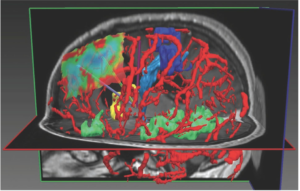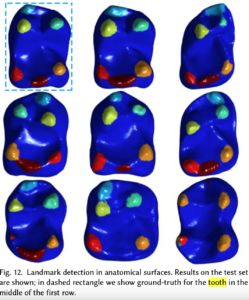A summary of my collaboration with Clalit Pharmacy. This blog serves as a technical guide, offering insights into coding with open-source packages dedicated to utilizing neural network models for time series data forecasting.
About a week following that Saturday, I came across an article in the news discussing the necessity of identifying dead individuals through their dental records. It occurred to me that I could contribute by leveraging my experience in medical image processing. Despite the emotional weight of this task, I found the technical aspect to be intriguing. It represents a classic example of an AI task that is both important and capable of significantly reducing the workload for dentists.
I began publishing during my Master’s program, and I’m the primary author of this paper. In this research paper, the main focus was on using image processing algorithms to improve the selection of neuronal trajectories during computer aided surgery. The following image displays the segmentation of neuronal structures. The red branches represent blood vessels, while the colored masses indicate functional areas such as motor, sensory (frontal), speech (peripheral), vision (posterior), and auditory (lateral). The colored map surface represents different risk areas on the skull, and the light purple tubes represent the trajectories.

Concerning this project, my name was mentioned in the Haaretz newspaper: Read the article

Recently, I delved into the cutting-edge segmentation technique called SAM (Segment Anything Model). As part of this review, I conducted experiments to segment a wide range of entities, encompassing tumors, polyps, organs, and more. In this blog, I provide a concise summary of similar research conducted by various esteemed research institutes, creating a comprehensive literature review. The question arises:
can SAM truly be considered a proficient segmentation tool in the domain of medical imaging, or does it fall short as a mere gimmick attempting to emulate the success of chatGPT?
A blog comparing various medical imaging platforms designed to assist hospitals and promote collaborative teamwork among medical professionals for the development of AI-based algorithms.
SIGGRAPH is considered one of the most exclusive conference in the field of computer vision and graphics, and I had the privilege of co-authoring this article with Weizmann team members during my doctoral candidacy. The paper presents a method based on extensive mathematical analysis for the automatic landmark detection of animal teeth.

As a data scientist, have you ever been asked: “does deep learning mimic the brain?” At this point, you are probably going red, as you wonder what and how to respond. Well, there are no wrong questions, but there are definitely bad answers … This blog tries to elucidate an answer by granting an intuition to the question of why use various neural-networks (NN) models in light of the amazing field known as molecular biology. These miniature molecules are rarely seen (perhaps they live on the edge in their mysterious world :-); however, they entirely compose our being, in every cell of any creatures on the planet. As has been hinted in the title, in this talk, I will cover ten life-sciences problems solved by utilizing the power of approximately ten neural network architectures, along with pointing out the downsides of other machine learning (ML) traditional algorithms.
When I first heard that there is an effort to discover drugs through machine learning methods, I was so enthusiastic by the thought that AI could suggest new drug compounds that I immediately put on my data scientist hat, ready to apply some cool deep learning methods in this field. Despite my good spirits, soon, I realized (again and again during my career in medical algorithms) that a method that works well in computer vision applications won’t necessarily work in drug discovery. I was motivated to uncover the reasons for this gap, and the result is here. I came up with 9 issues that I assume cause this that I would elaborate on below. If you engage with the drug discovery field, whether during a job application or as an entrepreneur, I recommend you to further research or discuss these issues. To help you with these interactions, I added on each topic an example for questions you could ask the company or yourself if you are trying to establish one.
Your genetics reveal not just your biological information but the genetics history of your ancestors by representing which dominant parts survived through the years (check out “ancestral sequence reconstruction”). In other words, it is the biological evolution coding of your family, and even more, according to Darwin’s Theory of Evolution, the entirety of the collection of organic creatures (plants, animals, etc.) all share the same genetic principles. The main focus of this blog is to explain the fundamentals of building neural networks specifically designed to analyze genetic data. I aim to identify the simplest and most compatible neural network architecture for this purpose.
Accuracy alone does not provide a comprehensive assessment of model performance; rather, we must consider the full range of prediction scores and various performance metrics to gain insights into the model’s interpretability and reveal the mid-level information captured in hidden layers, ultimately aiming to unveil new insights and shed light on the inner workings of the “black box.” In this blog, we will explore approximately 10 metrics, comparing and discussing their merits within their respective categories, and while the validation process, remains an open issue with extensive debates, our study is guided by solid and well-established arguments that drive the selection of evaluation metrics.
In this blog, I have created a brief self-assessment quiz to evaluate your AI comprehension.
This blog discusses the genetics of COVID-19 and provides essential background information on biological aspects, including DNA and RNA structure and the translation of genetic code into proteins. It introduces the SARS-CoV-2 structure and explains how the virus infects hosts. The blog then presents a literature review, covering topics related to diagnosing COVID-19, the evolution of SARS-CoV-2, the host gene receptor, and prediction methods using deep learning algorithms. It emphasizes the importance of understanding the Fasta file format and its content for exploring biological data and seeking answers to important questions related to the virus.
In this blog, I show you where you can obtain data related to the genetics of viruses, some reasonable thoughts about what you should consider while obtaining the data and lastly, a simple Python example on how to read and prepare the data for your research.
Viral transition is the path the virus achieves among different host species. Animal to human viral transmission is called zoonosis. Zoonotic diseases can be transmitted in any context in which there is contact with or consumption of animals, animal products, or animal derivatives. The following modes may give you a clue: food and water, farming, ranching, husbandry, pets, hunting, live animal market, etc. And these are only a small glance at what is actually going on … Within the framework of this research I focused on four viruses of two families: Coronaviridae (MERS and SARS-CoV-2 viruses) and Orthomyxoviridae (influenza A: H1N1 and H3N2 viruses), and discovered the next topics as the best match to the questions that I dealt with:
- Showing the diversity of hosts diagnosed with influenza type A and coronavirus
- Examining the genetic similarity between hosts — humans and nonhuman animals, in terms of viral DNA and protein sequences
- Exploring the dynamic behavior of viral transmissions